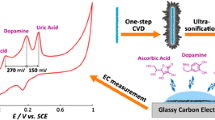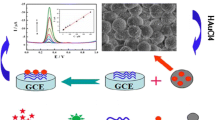Abstract
The authors describe a method for simultaneous voltammetric determination of 5-hydroxytryptamine (serotonin; 5-HT) and its metabolite 5-hydroxyindoleacetic acid (5-HIAA). A glassy carbon electrode was modified with poly(pyrrole-3-carboxylic acid) and with platinised carbon nanofibers to obtain a sensor that can quantify 5-HT and 5-HIAA with detection limits of 10 nM and 20 nM, respectively. The peak currents, best measured at voltages of 170 mV and 500 mV (vs. Ag/AgCl) for 5-HT and 5-HIAA, increase linearly in the 0.01–100 μM concentration range for both analytes. The method was successfully applied to the quantitation of 5-HT and 5-HIAA in spiked artificial urine samples, and the sensor can be used up to 10 days.

A new electroanalytical device was developed for separation and quantitation of 5-hydroxytryptamine (5-HT) and 5-hydroxyindole-3-acetic acid (5-HIAA), based on stripping square wave voltammetry, exploiting conducting polymer surfaces on platinised carbon nanofiber supports.





Similar content being viewed by others
References
Houghton LA, Atkinson W, Whitaker RP et al (2003) Increased platelet depleted plasma 5-hydroxytryptamine concentration following meal ingestion in symptomatic female subjects with diarrhoea predominant irritable bowel syndrome. Gut 52:663–670
Some M, Helander A (2002) Urinary excretion patterns of 5-hydroxyindole-3-acetic acid and 5-hydroxytryptophol in various animal species: implications for studies on serotonin metabolism and turnover rate. Life Sci 71:2341–2349
Garver DL, Davis JM (1979) Biogenic amine hypotheses of affective disorders. Life Sci 24:383–394
Wang Z, Liang Q, Wang Y, Luo G (2003) Carbon nanotube-intercalated graphite electrodes for simultaneous determination of dopamine and serotonin in the presence of ascorbic acid. J Electroanal Chem 540:129–134. https://doi.org/10.1016/S0022-0728(02)01300-1
Zen JM, Chen IL, Shih Y (1998) Voltammetric determination of serotonin in human blood using a chemically modified electrode. Anal Chim Acta 369:103–108
Chatzittofis A, Nordström P, Hellström C, Arver S, Åsberg M, Jokinen J (2013) CSF 5-HIAA, cortisol and DHEAS levels in suicide attempters. Eur Neuropsychopharmacol J Eur Coll Neuropsychopharmacol 23:1280–1287. https://doi.org/10.1016/j.euroneuro.2013.02.002
Moberg T, Nordström P, Forslund K, Kristiansson M, Åsberg M, Jokinen J (2011) CSF 5-HIAA and exposure to and expression of interpersonal violence in suicide attempters. J Affect Disord 132:173–178. https://doi.org/10.1016/j.jad.2011.01.018
Goyal RN, Oyama M, Gupta VK, Singh SP, Sharma RA (2008) Sensors for 5-hydroxytryptamine and 5-hydroxyindole acetic acid based on nanomaterial modified electrodes. Sens Actuators B Chem 134:816–821. https://doi.org/10.1016/j.snb.2008.06.027
Tormey WP, FitzGerald RJ (1995) The clinical and laboratory correlates of an increased urinary 5-hydroxyindoleacetic acid. Postgrad Med J 71:542–545
Banik S, Lahiri T (2000) Increase in brain serotonin level and concomitant reduction in food intake and body weight of mice bearing chemically - induced Fibrosarcoma. Biomed Res 21:255–261. https://doi.org/10.2220/biomedres.21.255
Dursun SM, Whitaker RP, Andrews H, Reveley MA (1999) Effects of natural ageing on plasma 5-HT turnover in humans. Hum Psychopharmacol Clin Exp 12:365–367. https://doi.org/10.1002/(SICI)1099-1077(199707/08)12:4<365::AID-HUP879>3.0.CO;2-2
Xu H, Zhang W, Wang D, Zhu W, Jin L (2007) Simultaneous determination of 5-hydroxyindoleacetic acid and 5-hydroxytryptamine in urine samples from patients with acute appendicitis by liquid chromatography using poly(bromophenol blue) film modified electrode. J Chromatogr B Analyt Technol Biomed Life Sci 846:14–19. https://doi.org/10.1016/j.jchromb.2006.08.021
Nohta H, Yukizawa T, Ohkura Y, Yoshimura M, Ishida J, Yamaguchi M (1997) Aromatic glycinonitriles and methylamines as pre-column fluorescence derivatization reagents for catecholamines. Anal Chim Acta 344:233–240. https://doi.org/10.1016/S0003-2670(96)00614-9
Zhang L, Zhao Y, Huang J, Zhao S (2014) Simultaneous quantification of 5-hydroxyindoleacetic acid and 5-hydroxytryptamine by capillary electrophoresis with quantum dot and horseradish peroxidase enhanced chemiluminescence detection. J Chromatogr B Analyt Technol Biomed Life Sci 967:190–194. https://doi.org/10.1016/j.jchromb.2014.07.002
Moriarty M, Lee A, O’Connell B, Kelleher A, Keeley H, Furey A (2011) Development of an LC-MS/MS method for the analysis of serotonin and related compounds in urine and the identification of a potential biomarker for attention deficit hyperactivity/hyperkinetic disorder. Anal Bioanal Chem 401:2481–2493. https://doi.org/10.1007/s00216-011-5322-7
Bracamonte AG, Veglia AV (2011) Spectrofluorimetric determination of serotonin and 5-hydroxyindoleacetic acid in urine with different cyclodextrin media. Talanta 83:1006–1013. https://doi.org/10.1016/j.talanta.2010.11.013
Adams RN (1976) Probing brain chemistry with electroanalytical techniques. Anal Chem 48:1126A–1138A. https://doi.org/10.1021/ac50008a001
Leszczyszyn DJ, Jankowski JA, Viveros OH et al (1990) Nicotinic receptor-mediated catecholamine secretion from individual chromaffin cells. Chemical evidence for exocytosis J Biol Chem 265:14736–14737
Mozaffari SA, Chang T, Park S-M (2010) Self-assembled monolayer as a pre-concentrating receptor for selective serotonin sensing. Biosens Bioelectron 26:74–79. https://doi.org/10.1016/j.bios.2010.05.015
Liu M, Crussière M, Hélard JF (2010) Enhanced two-dimensional data-aided channel estimation for TDS-OFDM. In: 2010 4th international conference on signal processing and communication systems. Pp 1–7
Wang F, Wu Y, Lu K, Ye B (2013) A simple but highly sensitive and selective calixarene-based voltammetric sensor for serotonin. Electrochim Acta 87:756–762. https://doi.org/10.1016/j.electacta.2012.09.033
Zhao H, Bian X, Galligan JJ, Swain GM (2010) Electrochemical measurements of serotonin (5-HT) release from the Guinea pig mucosa using continuous amperometry with a boron-doped diamond microelectrode. Diam Relat Mater 19:182–185
Ran G, Chen C, Gu C (2015) Serotonin sensor based on a glassy carbon electrode modified with multiwalled carbon nanotubes, chitosan and poly(p-aminobenzenesulfonate). Microchim Acta 182:1323–1328. https://doi.org/10.1007/s00604-015-1454-3
Gomez FJV, Martín A, Silva MF, Escarpa A (2015) Screen-printed electrodes modified with carbon nanotubes or graphene for simultaneous determination of melatonin and serotonin. Microchim Acta 182:1925–1931. https://doi.org/10.1007/s00604-015-1520-x
Sharma S, Singh N, Tomar V, Chandra R (2018) A review on electrochemical detection of serotonin based on surface modified electrodes. Biosens Bioelectron 107:76–93. https://doi.org/10.1016/j.bios.2018.02.013
Makrlíková A, Ktena E, Economou A, Fischer J, Navrátil T, Barek J, Vyskočil V (2016) Voltammetric determination of tumor biomarkers for Neuroblastoma (Homovanillic acid, Vanillylmandelic acid, and 5-Hydroxyindole-3-acetic acid) at screen-printed carbon electrodes. Electroanalysis 29:146–153. https://doi.org/10.1002/elan.201600534
Ravichandran R, Sundarrajan S, Venugopal JR, Mukherjee S, Ramakrishna S (2010) Applications of conducting polymers and their issues in biomedical engineering. J R Soc Interface 7:S559–S579. https://doi.org/10.1098/rsif.2010.0120.focus
Brooks T, Keevil CW (1997) A simple artificial urine for the growth of urinary pathogens. Lett Appl Microbiol 24:203–206
Singh B, Dempsey E, Dickinson C, Laffir F (2012) Inside/outside Pt nanoparticles decoration of functionalised carbon nanofibers (Pt19.2/f-CNF80.8) for sensitive non-enzymatic electrochemical glucose detection. Analyst 137:1639–1648. https://doi.org/10.1039/C2AN16146J
Singh B, Dempsey E (2013) Exceptional Pt nanoparticle decoration of functionalised carbon nanofibers: a strategy to improve the utility of Pt and support material for direct methanol fuel cell applications. RSC Adv 3:2279–2287. https://doi.org/10.1039/C2RA21862C
Dinesh B, Veeramani V, Chen S-M, Saraswathi R (2017) In situ electrochemical synthesis of reduced graphene oxide-cobalt oxide nanocomposite modified electrode for selective sensing of depression biomarker in the presence of ascorbic acid and dopamine. J Electroanal Chem 786:169–176. https://doi.org/10.1016/j.jelechem.2017.01.022
Swamy BEK, Venton BJ (2007) Carbon nanotube-modified microelectrodes for simultaneous detection of dopamine and serotonin in vivo. Analyst 132:876–884. https://doi.org/10.1039/b705552h
Antuña-Jiménez D, Blanco-López MC, Miranda-Ordieres AJ, Lobo-Castañón MJ (2015) Artificial enzyme-based catalytic sensor for the electrochemical detection of 5-hydroxyindole-3-acetic acid tumor marker in urine. Sens Actuators B Chem 220:688–694. https://doi.org/10.1016/j.snb.2015.05.109
Satyanarayana M, Koteshwara Reddy K, Vengatajalabathy Gobi K (2014) Nanobiocomposite Based Electrochemical Sensor for Sensitive Determination of Serotonin in Presence of Dopamine, Ascorbic Acid and Uric Acid In Vitro. Electroanalysis 26:2365–2372. https://doi.org/10.1002/elan.201400243
Anithaa AC, Asokan K, Sekar C (2017) Highly sensitive and selective serotonin sensor based on gamma ray irradiated tungsten trioxide nanoparticles. https://doi.org/10.1016/j.snb.2016.07.098
Wang Y, Wang S, Tao L, Min Q, Xiang J, Wang Q, Xie J, Yue Y, Wu S, Li X, Ding H (2015) A disposable electrochemical sensor for simultaneous determination of norepinephrine and serotonin in rat cerebrospinal fluid based on MWNTs-ZnO/chitosan composites modified screen-printed electrode. Biosens Bioelectron 65:31–38. https://doi.org/10.1016/j.bios.2014.09.099
Acknowledgements
This work was partially funded by the “SMARTCANCERSENS” project Marie Curie IRSES staff exchange programme - Grant Agreement PIRSES-GA 2012-318053.
Author information
Authors and Affiliations
Corresponding author
Ethics declarations
The author(s) declare that they have no competing interests.
Electronic supplementary material
ESM 1
(DOCX 2013 kb)
Rights and permissions
About this article
Cite this article
Fredj, Z., Ali, M., Singh, B. et al. Simultaneous voltammetric detection of 5-hydroxyindole-3-acetic acid and 5-hydroxytryptamine using a glassy carbon electrode modified with conducting polymer and platinised carbon nanofibers. Microchim Acta 185, 412 (2018). https://doi.org/10.1007/s00604-018-2949-5
Received:
Accepted:
Published:
DOI: https://doi.org/10.1007/s00604-018-2949-5




